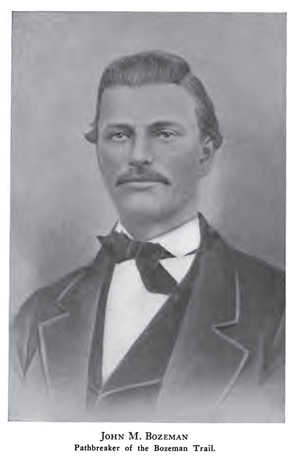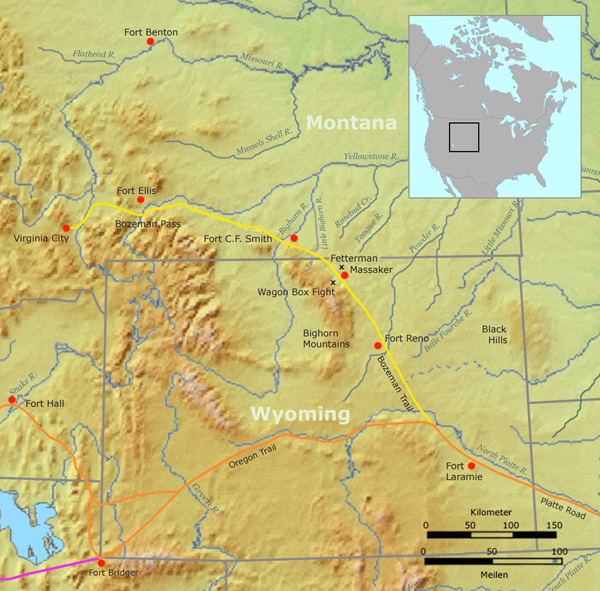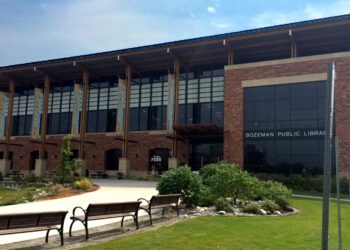More tragedy than convenience
By Frederick Gientke Explorebigsky.com Contributor
Just north of Gallatin Canyon lies the trace of a historic trail that, despite its brief life, had a bloody and terrifying history. Called the Bozeman Trail, its name memorializes the individual who publicized it as a shortcut to the Montana goldfields.
 In 1863, John Bozeman and his companion John Jacobs re-discovered an ancient trail through Wyoming and Montana that would shorten the journey for travelers then using the Bridger Trail to the west. Over the next five years, almost 3,500 people used the Bozeman Trail, many of whom were miners heading for the Montana Territory gold mines near Virginia City and Bannack, in Southwest Montana.
In 1863, John Bozeman and his companion John Jacobs re-discovered an ancient trail through Wyoming and Montana that would shorten the journey for travelers then using the Bridger Trail to the west. Over the next five years, almost 3,500 people used the Bozeman Trail, many of whom were miners heading for the Montana Territory gold mines near Virginia City and Bannack, in Southwest Montana.
Prior to the Bozeman Trail, miners used the much longer Bridger Trail that passed west of Wyoming’s Bighorn Mountains, thereby avoiding the Indian tribes that fiercely protected their hunting grounds.
Bozeman, then 28, didn’t create the trail, but documented and made known a route that had been in existence and use for many decades by bison, Indians and trappers. The trail itself was a wide corridor over which travelers moved, rather than a narrow, conventional road. Bozeman was also instrumental in laying out and naming the City of Bozeman in 1864.
The Indians resented the trail and its interruption of wildlife migration, and tension built. Because random killings were common between travelers and Indians, the U.S. Army constructed three forts to protect the trespassing travelers: Fort Reno, Fort Phil Kearny and Fort C. F. Smith.
One of the bloodiest incidents along the trail occurred about 15 miles south of Sheridan, Wyo. In December 1866, several thousand Sioux, Cheyenne and Arapahoe led by Chief Red Cloud ambushed two army companies under the command of a young and Indian-inexperienced Captain William J. Fetterman. The infantry and cavalrymen had been dispatched to rescue woodcutters sent out from the fort. Within about 30 minutes, the entire 80-man detachment was wiped out.
Because of continued Indian resistance to encroachment by the travelers, the army abandoned the three forts in 1868 and discontinued use of the Bozeman Trail.
Bozeman himself was slain the year prior. He was camped on Mission Creek just east of Livingston, and was ambushed by a group of four Blackfeet Indians. He was buried in a cemetery in Bozeman.
The trail contributed to the start of the widespread 1876 Sioux War between the U.S. Army and the Sioux and Cheyenne Indians. Major battles of this war raged throughout eastern Montana and the surrounding areas, as the Indians desperately tried to protect their way of life.
Ultimately, white man’s greed, treachery, treason and repeated ruthless attacks on Indian villages were the major reasons the Indians were captured, subjugated and placed on reservations. For Washington to achieve these results, the price was exorbitant; Custer, Fetterman, Crazy Horse and thousands of other combatants and families on both sides were killed in the last half of the 1800s. In the end, the cherished Indian lands were converted to ranches for cattle and other livestock.
Today, sections of the trail are still visible, and many monuments have been constructed to identify its historical alignment and location. A lonely, dusty monument near the Powder River marks the site where Fort Reno once sat. Remnants of Fort Kearney still exist, along with a gift and information shop; the vista and history at that site is worth a trip. As for C.F. Smith—beaten remains of the Fort’s adobe walls stand atop the cliffs of the Bighorn River near the trail’s historic crossing.
Frederick Gientke is a retired civil engineer specializing in western water projects. He is currently writing a book entitled Custer Abandoned.














